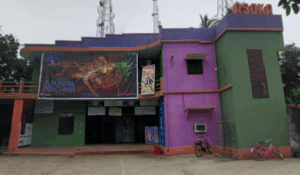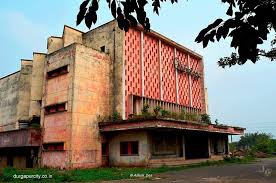
A Day at Aska – A Reflection on the State of Odia Cinema
A Personal Encounter That Mirrors the Odia Cinema Audience

I was in Aska, a small town in southern Odisha, working as a VFX Supervisor on a regional project. After weeks of long, tiring workdays, I finally got a day off. My roommate and I decided to watch an Odia film, something we hadn’t done in a while. We wanted to experience the charm of an old cinema hall and connect again with the Odia Cinema Audience, whose presence once defined the glory of local films.
We started the day with a hearty Odia breakfast of puri, ghuguni, and tea before heading to an old single-screen theatre beside the market.
At the counter, the ticket seller said politely,
“Babu, the show will start only if ten people come. Right now, only five tickets are sold — including yours. Let’s wait for 30 minutes.”
We laughed and stepped out for a smoke. Fifteen minutes later, we saw a lone traveller — who was just passing time before his bus — returning his ticket in frustration. When we reached the counter again, the seller informed us that the show was being cancelled.
“Viewers are too few. Even the basic projection cost can’t be recovered,” he explained softly.
My friend, frustrated, suddenly remembered that he knew the producer-director of the film. He called him and complained.
The producer replied calmly,
“Wait there. I’ll handle it.”
Within minutes, the seller received a call. The producer had just bought seven tickets online, pushing the total number to ten. “Okay babu, the show will go on,” the seller said, smiling faintly.
That day wasn’t just about a movie. It was a reflection of the state of the Odia film industry — an industry rich in potential yet shackled by its own choices.
The Harsh Truth Behind the Silver Screen

Having worked in and around Odia cinema, I have observed many of its flaws firsthand. What happened in Aska is symbolic of larger issues — creative, technical, structural, and cultural — that continue to hold Odia films back.
1. Repetitive Storytelling and Its Effect on the Odia Cinema Audience
Today’s audience has access to OTT platforms and global cinema, from Korean dramas to Malayalam masterpieces. In comparison, Odia cinema remains stuck in the 1980s — reusing the same plot lines, dialogues, and song-dance sequences.
While technology has improved, storytelling hasn’t evolved. The stories lack originality and freshness. The world has moved to realistic, character-driven plots, but Odia movies still revolve around outdated tropes. People are paying the same ticket price to watch better content online. Naturally, Odia films lag behind — not due to lack of talent, but due to creative stagnation.
2. Lack of Innovation and Technical Growth: Losing the Modern Odia Cinema Audience
Innovation in the Odia film industry is painfully slow. The issue isn’t the absence of creativity but the placement of the wrong people in key roles. Decisions are often driven by personal interests rather than cinematic merit.
Technicians are more interested in camera upgrades than storytelling. The conversation always circles around equipment — drones, lenses, rigs — instead of scripts, characters, and narrative emotion. Everyone chases short-term profits rather than long-term artistry.
Though budget constraints are often cited as excuses, many problems can be solved with reverse engineering and proper planning. Unfortunately, few filmmakers invest in pre-production or creative workshops. Most departments work superficially, except for a handful of serious DOPs who still treat cinema as art, not just a job.
True innovation doesn’t come from expensive cameras — it comes from telling powerful stories with conviction.
3. Weak Marketing and Limited Reach to the Odia Cinema Audience

In modern filmmaking, marketing is as vital as production, but Odia filmmakers rarely understand this. For most, marketing begins and ends with casting a star.
Having a familiar face may grab 10% of attention, but the other 90% depends on content. Filmmakers forget that audiences come for the story, not for the star’s face on a poster. Yet promotional material focuses entirely on actors rather than the film’s essence.
Even the trailers — the first impression of a movie — often fail to create excitement. They are poorly edited, lack rhythm, and show too much or too little. When audiences compare Odia trailers to those from other regional industries, they feel an instant kickback — a sense of disappointment before even watching the film.
Good marketing is not about hype; it’s about building trust through authenticity. The Odia film industry must learn to sell the experience, not the celebrity, if it wants to regain audience confidence.
4. Poor Theatre Infrastructure and Its Impact on the Odia Cinema Audience Experience

Most single-screen theatres in Odisha are in a state of decay. Broken chairs, dim lights, muffled sound, and flickering projectors have become the norm. The infrastructure is barely functional, making the movie-watching experience more exhausting than enjoyable.
Audiences, now used to OTT platforms and multiplex standards, find it difficult to spend money in such poor conditions. As attendance falls, theatre owners cannot afford maintenance, leading to further decline. It’s a vicious cycle of neglect.
Moreover, many theatres still run on outdated projection and sound systems, which ruin even well-made films. If the environment itself discourages viewers, how can the industry grow?
To revive Odia cinema, the government and private investors must work together to modernize cinema halls and create better exhibition spaces — because cinema isn’t just an art form; it’s an experience.
5. Disconnect from Modern Odisha: Why the Odia Cinema Audience Feels Detached

Cinema must reflect its people and their stories. Unfortunately, many Odia films today feel disconnected from modern Odisha. Instead of drawing from local traditions, dialects, and lifestyles, filmmakers imitate visuals from other regions, breaking the cultural bond with audiences.
A clear example is the inclusion of unrealistic scenes — such as MMA-style fight sequences — which have no place in Odia society. Similarly, costumes and sets often mimic South or North Indian styles, creating a visual identity crisis.
Another growing issue is the choice of shooting locations. Many filmmakers shoot songs and sequences in foreign or distant locations just to make them look “beautiful.” But beauty is not about exotic backdrops — it’s about emotional connection.
If filmmakers shoot in local Odia towns, villages, and landmarks, audiences will feel proud and emotionally invested. Seeing familiar streets, temples, or beaches on screen gives people a sense of ownership and belonging. It boosts local morale and audience loyalty.
Odisha’s landscapes — from Koraput’s forests to Puri’s coastline — hold cinematic beauty that rivals any other region. Using these authentic settings will not only strengthen identity but also bring Odia cinema back to its roots.
When films start reflecting the real Odisha, audiences will stop being passive viewers and start being active supporters.
6. Lack of Professionalism and Vision: Disappointing the Loyal Odia Cinema Audience

Vision in cinema comes from discipline and professionalism, two qualities often missing in Odia filmmaking. Many films begin without proper scripts, schedules, or creative planning.
Audiences today have seen superhero films like Lokha and global masterpieces across genres. Why would they settle for repetitive fight sequences and outdated storytelling? Creativity has stagnated, replaced by dependence on luck.
Songs often feel misplaced — resembling TV serial numbers rather than cinematic compositions. Filmmakers believe that speaking in Odia is enough to make a film Odia, forgetting that cultural pride comes from connection, not language alone.
Without training programs, mentorships, or creative labs, filmmakers operate in isolation. To grow, Odia cinema needs an ecosystem that values professionalism, collaboration, and continuous learning.
7. Lack of Consistency and Unity: Struggling to Retain the Odia Cinema Audience

Odia cinema suffers from inconsistency. One good film excites audiences, but the next nine push them away again. Each success story is followed by a wave of mediocrity. This inconsistency destroys audience trust.
The industry is divided into small camps, each working independently with its own circle of actors and technicians. Instead of uniting as an industry, they compete as rivals. In a small market, too many self-proclaimed stars and inflated egos create unnecessary division.
For real progress, the Odia film community must embrace unity over ego and quality over quantity. Consistent storytelling, collaboration, and humility are the only ways to rebuild trust.
A Creative Industry in Need of Revival

In my years of working with Odia filmmakers, I’ve met many who are serious, talented, and passionate about cinema. But their creative aspirations are often suppressed by an unhealthy environment — one that discourages experimentation, rewards mediocrity, and fears change.
It’s not a lack of skill — it’s a lack of freedom, unity, and shared vision. Odisha has stories worth telling, landscapes worth showing, and emotions worth celebrating. The industry must rediscover its authentic voice and embrace collaboration instead of competition.
That day in Aska — when a producer bought seven tickets just to keep his own film playing — symbolized both the fragility and the resilience of Odia cinema. It proved that even in struggle, there is hope born of passion.
Odia cinema doesn’t need to imitate the world; it just needs to rediscover its soul.

